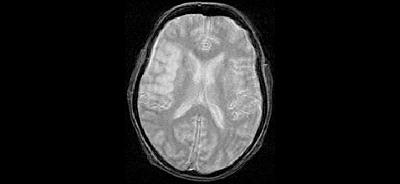Spectroscopy
Magnetic Resonance Spectroscopy (MRS) is a non-invasive diagnostic test for measuring biochemical changes in the brain. This provides valuable information regarding the brain’s chemistry by using the same resonance phenomenon as MR imaging (MRI).
Overview
MR Spectroscopy (MRS) can be used alongside a conventional MRI protocol to enable the serial monitoring of biochemical changes.
Purpose
We can apply MRS to investigate biochemical changes which occur in the early stages of diseases such as stroke, tumours, epilepsy, metabolic disorders, infections and neuro-degenerative diseases.

- Figure 1. T2-weighted image of a patient with a recent right middle cerebral artery territory stroke (hyperintense region on left of image).

- Figure 2. Array of long echo-time spectra (TE=145ms) from the same patient. Note reduced NAA, choline and creatine peaks in the stroke region, and presence of lactate (inverted doublet peak) in several spectra around the medial edge of the lesion.
Detail
There are two types of spectroscopy techniques. - single voxel spectrospy (SVS) and chemical shift imaging (CSI).
The Edinburgh Imaging Facilities - RIE and QMRI, carry out both SVS and CSI techniques. The most commonly measured metabolites are:
- Creatine (involved in the cellular energy cycle)
- Choline (a constituent of cell membranes)
- N-acetyl aspartate (a neuronal marker)
- Lactate (a by-product of anaerobic metabolism, and thus a marker of ischaemia)
Contact
Relevant links
In the news

